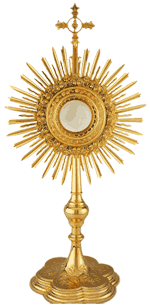 After her Son’s Ascension, Mary aided the beginnings of the Church by her prayers. In her association with the apostles and several women, we also see Mary by her prayers imploring the gift of the Spirit, who had already overshadowed her in the Annunciation. Finally the Immaculate Virgin, preserved free from all stain of original sin, when the course of her earthly life was finished, was taken up body and soul into heavenly glory, and exalted by the Lord as Queen over all things, so that she might be the more fully conformed to her Son, the Lord of lords and conqueror of sin and death.
After her Son’s Ascension, Mary aided the beginnings of the Church by her prayers. In her association with the apostles and several women, we also see Mary by her prayers imploring the gift of the Spirit, who had already overshadowed her in the Annunciation. Finally the Immaculate Virgin, preserved free from all stain of original sin, when the course of her earthly life was finished, was taken up body and soul into heavenly glory, and exalted by the Lord as Queen over all things, so that she might be the more fully conformed to her Son, the Lord of lords and conqueror of sin and death.
The Assumption of the Blessed Virgin is a singular participation in her Son’s Resurrection and an anticipation of the resurrection of other Christians: In giving birth you kept your virginity; in your Dormition you did not leave the world, O Mother of God, but were joined to the source of Life. You conceived the living God and, by your prayers, will deliver our souls from death.
When we speak of the origin, mission, and destiny of the Church, we can find no better way to conclude than by looking to Mary. In her we contemplate what the Church is at present through its “pilgrimage of faith,” and what the Church will be in the homeland at the end of the Church’s journey. There, “in the glory of the Most Holy and Undivided Trinity,” “in the communion of all the saints,” the Church is awaited by the one she venerates as Mother of her Lord and as her own mother.
In the meantime the Mother of Jesus, in the glory which she possesses in body and soul in heaven, is the image and beginning of the Church as it is to be perfected in the world to come. Likewise she shines forth on earth, until the day of the Lord shall come, a sign of certain hope and comfort to the pilgrim People of God.




